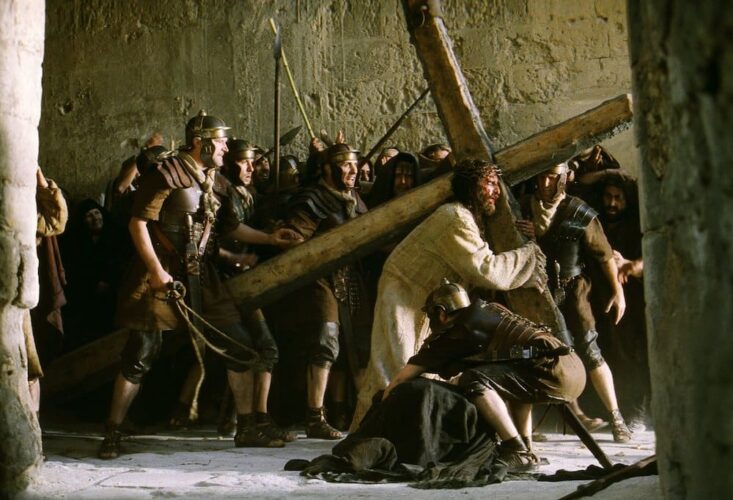Retrospective: The Passion of the Christ

Jesus of Nazareth falls to his knees, drops of blood pouring down his face. He is on his knees in Gethsemane. He is on his knees as the Romans tear out chunks of his flesh with a cat o’ nine tails. And he is on his knees as he stumbles towards Golgotha. Christ spends most of the film prostrate or kneeling. He experiences the totality of suffering in a single agonizing night.

What a suitable metaphor for Mel Gibson’s The Passion of the Christ. Every aspect of the movie burns: it is torturously violent, self-loathing, and hateful. That’s not a criticism — if a dramatization of the Passion were anything less than excruciating to watch, it would be an abject failure. Criticisms of The Passion as torture porn miss the point. The Gospels are the story of a man subjected to the worst punishment his civilization has to offer, compounded by the divine experience of all sin throughout time.
No, the failures of The Passion are not aesthetic. The Passion of the Christ is one of the best fascist films ever made. It makes a coherent story out of the Passion narrative — no mean feat for such an episodic, ancient, contradictory mish-mash of accounts — and marries it with astonishing iconography to create a textually rich and dramatic rendering of the Christ mythology. The character work is genuinely brilliant — the sense that Jesus is normally a genial, spirited man who’s acting completely out of character is imparted delicately and intelligently. Peter’s character is handled particularly well — after falling to Mary’s feet, declaring himself unworthy of love for betraying Jesus, he runs away, instead of making amends by accompanying Mary to the cross. And the intercutting of Mary running to Jesus as he falls with a similar incident from childhood is genuinely moving. The saints in The Passion are fallible, sometimes ugly people. Catholic movies are rarely so honest.
Yet The Passion famously withholds the courtesy of three-dimensional characterization to its mostly explicitly Jewish characters. You don’t have to cite Mel Gibson’s history of personal antisemitism or his rabidly anti-Jewish source material to see the jaw-dropping antisemitism in The Passion of the Christ. Gibson envisions Judea as manipulated by a Jewish cabal of big-nosed, money-grubbing sycophants who manipulate the Romans into achieving their goals. Not a moment of the movie explores Caiaphas’ motivations or grants them any credence. He is simply the conniving Jew who has the Messiah executed.
Most damningly, Gibson extends his sympathy to the Romans, the actual killers of Jesus. Pontius Pilate is afraid of losing his position despite sympathizing with Jesus, and caves to the intransigent, bloodthirsty Jewish rabble out of fear. The single most sinister aspect of this is The Passion’s fleeting acknowledgment of Pontius Pilate’s real history. Pilate put down a Samarian revolt so brutally that Rome fired him. This man was actually too bloodthirsty for Rome. But in Gibson’s Europhilic, sedevacantist conception of history, the face of Rome in Judea has to be sympathetic.…
